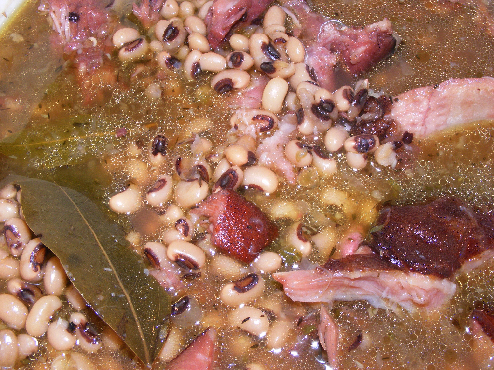Black Eyed Peas: Stewed Black Eyed Peas
Tuesday, December 29th, 2009Get ready for the hoopla – banging pots and pans, fireworks, and even firearms shooting off. Yikes! These are just a few of the ways people around the world welcome in the New Year. Originally, these loud rituals were believed to frighten away bad spirits and ensure a good year to come. Me, I’ll be doing something a bit more tame – cooking up a pot of black eyed peas.
 Eating black eyed peas on New Year’s Day is a longtime custom among African Americans and Southerners who believe the legumes will bring prosperity and good luck, especially when paired with greens, which symbolize money. Some folks say you just need to eat a spoonful and others say at least 365 (one for each day of the year). Regardless, this year, in this economy, the superstitious dare not skip this tradition.
Eating black eyed peas on New Year’s Day is a longtime custom among African Americans and Southerners who believe the legumes will bring prosperity and good luck, especially when paired with greens, which symbolize money. Some folks say you just need to eat a spoonful and others say at least 365 (one for each day of the year). Regardless, this year, in this economy, the superstitious dare not skip this tradition.
Some prefer to get their good fortune via a rice and black eyed pea dish called Hoppin’ John. I, however, prefer my peas simmered for several hours until they become creamy. That’s how my in-laws cook them up and how I’ve been eating them for almost two decades. They make a delicious meal served with a dash of Louisiana style hot sauce and maybe some vinegar, along with a generous portion of greens and big ‘ole slice of corn bread.
Black eyed peas can be found in most markets, either dried (found with other legumes), frozen or canned. If you have the time, make them from scratch with this recipe. There really is no substitute. But, if you cannot, opt for the frozen over the canned.
Happy New Year! Below are a few more New Year’s traditions that might pique your interest. Let me know if you have any to share.
Other New Year’s Rituals:
- Good luck will follow to couples who feed each other grapes during the last 12 seconds of the year. Feed your love interest 12 grapes, representing 12 months in the year; one with each stroke of the countdown and make a wish (Spain and Latin American countries).
- In you want to travel in the New Year, take your luggage outside and walk around at midnight (Mexico).
- Eat round-shaped foods such as grapes and prepared desserts for luck; eat noodles for a long life (Philippines).
- Wear red underwear at midnight for luck with love in the upcoming year or yellow underwear for luck with money (Mexico).
- For those who are thrill seekers, plunge into icy waters for a polar bear swim on New Year’s Day (Canada).






